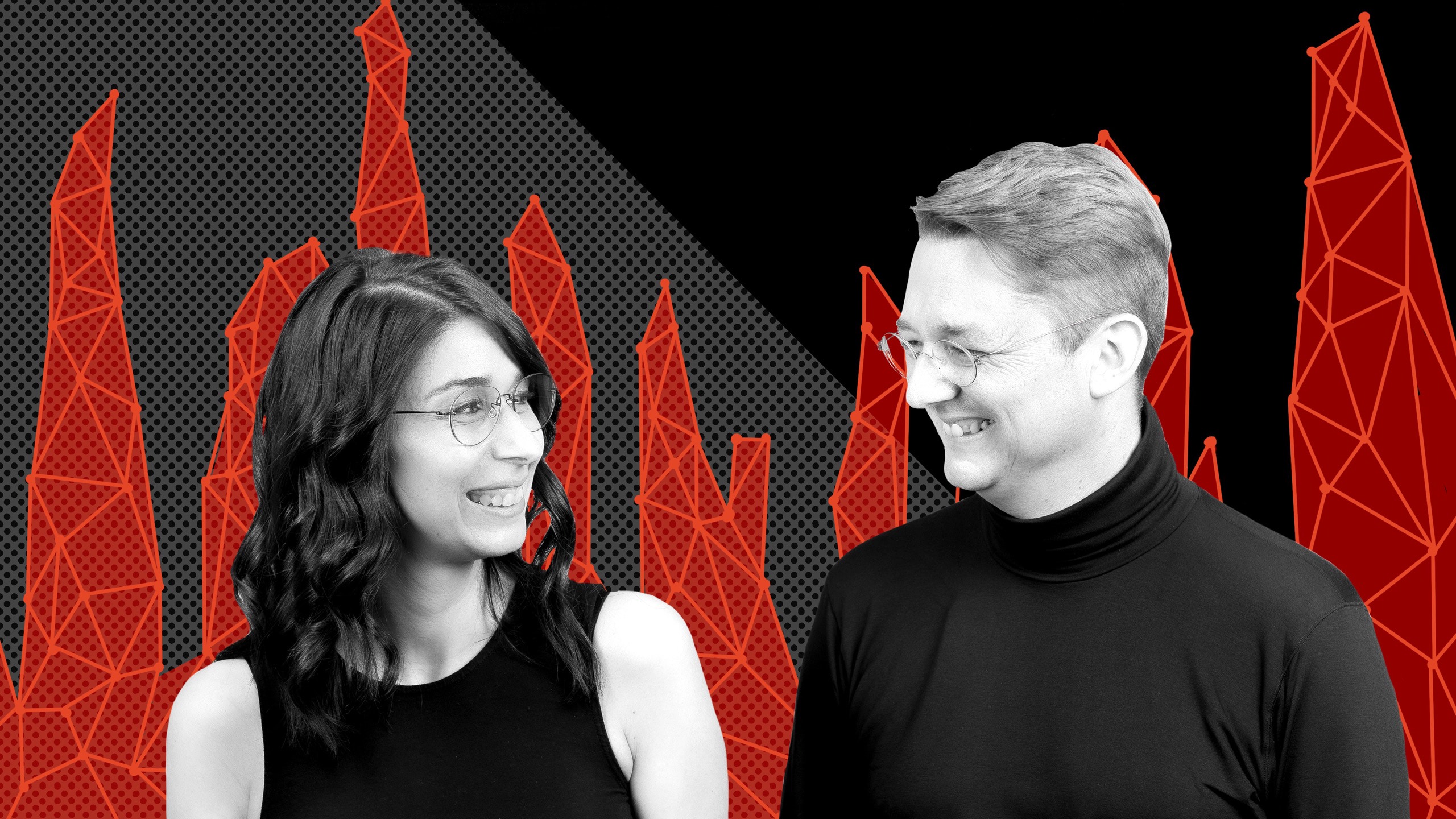Sandra Peter and Kai RiemerSandra Peter, Kai Riemer,
text

Neon and chip shortages
This week: the world’s leading suppliers of neon are in Ukraine, and that threatens to make the ongoing microchip shortage even worse.
Sandra Peter (Sydney Business Insights) and Kai Riemer (Digital Futures Research Group) meet once a week to put their own spin on news that is impacting the future of business in The Future, This Week.
The stories this week
07:05 – Russia’s attack on Ukraine halts half of world’s neon output for chips
Other stories we bring up
Renault resumes car production in Moscow
Renault has resumed manufacturing in its plants in Moscow
Why WhatsApp Survived Russia’s Social Media Purge
Meta branded as an “extremist organization” and banned Facebook and Instagram
Ukraine produces around 70% of global neon gas exports
Our previous discussion on cobalt and the challenges of the renewable energy transition
How the Ukraine crisis could make the chip shortage worse
The global fight over chips is about to get worse
Global chip shortage may soon turn into an oversupply crisis
Is the world still too dependent on Asia to solve the chip shortage?
Drought conditions show just how much water chipmakers use
Chipmaker factory fire in Germany leads to even more supply shortages
Chip shortage cost the US economy an estimated $240 billion in 2021
EU’s plan to switch from just-in-time to just-in-case production for chips
The toxic cocktail sparking a commodity crisis
Climate and resource security megatrend
Robot of the week
Kawasaki’s new deeply weird, chaotic robotic goat, Bex
Follow the show on Apple Podcasts, Spotify, Overcast, Google Podcasts, Pocket Casts or wherever you get your podcasts. You can follow Sydney Business Insights on Flipboard, LinkedIn, Twitter and WeChat to keep updated with our latest insights.
Send us your news ideas to sbi@sydney.edu.au.
Music by Cinephonix.
Dr Sandra Peter is the Director of Sydney Executive Plus at the University of Sydney Business School. Her research and practice focuses on engaging with the future in productive ways, and the impact of emerging technologies on business and society.
Kai Riemer is Professor of Information Technology and Organisation, and Director of Sydney Executive Plus at the University of Sydney Business School. Kai's research interest is in Disruptive Technologies, Enterprise Social Media, Virtual Work, Collaborative Technologies and the Philosophy of Technology.
Share
We believe in open and honest access to knowledge. We use a Creative Commons Attribution NoDerivatives licence for our articles and podcasts, so you can republish them for free, online or in print.
Transcript
Disclaimer We'd like to advise that the following program may contain real news, occasional philosophy and ideas that may offend some listeners.
Sandra So one of our listeners, Blair.
Kai Blair Wang, who's also a colleague at the Business School.
Sandra Found this super-interesting story about neon the gas, and chip shortages.
Kai And what a shortage in neon tells us about global supply chains.
Sandra It was really interesting.
Kai So we're going to talk about that.
Sandra Neon.
Intro From The University of Sydney Business School, this is Sydney Business Insights, an initiative that explores the future of business. And you're listening to The Future, This Week, where Sandra Peter and Kai Riemer sit down every week to rethink trends in technology and business.
Kai So Sandra, what are we talking about today?
Sandra Well, I think we're again talking about more fallout from the conflict in Ukraine. And one story follows the banning of Facebook and Instagram. So Meta was branded an extremist organisation, usually reserved for terrorist organisations. But in this case, Russia ruled that Meta was carrying out extremist activities by reporting or by allowing posts sharing what is happening in Ukraine. Hence both platforms, both Facebook and Instagram, have been banned.
Kai But the article wonders why does that not extend to WhatsApp which is equally owned by Meta aka Facebook but is still allowed to be used by Russian users and was not included in this ban.
Sandra And interestingly, the article mentions that the decision, the court ruling, specified that this was due to the lack of functionality for public dissemination of information that made WhatsApp exempt from the same ban that saw Facebook and Instagram banned in Russia.
Kai And there might be some truth to that, because when users post about the war in Ukraine, then that content is accessible to everyone. Whereas WhatsApp, as a more communication instant messaging-focused app, keeps communication between users more private, although some groups on WhatsApp can be very large. But there are likely other reasons as well. One might be that the decision to ban Facebook and Instagram is performative in the sense that it is very visible in the Western media when Facebook and Instagram are being banned. But in terms of user numbers, these platforms are not as popular as WhatsApp. So it doesn't inconvenience as many users in Russia to ban Facebook and Instagram, whereas WhatsApp is one of the most popular ways to communicate in Russia, and other parts of Europe equally.
Sandra But it's still interesting that WhatsApp is still perceived as a kind of a private platform, so this idea of not being able to publicly disseminate information on it. Which is kind of strange given, as you mentioned, the fact that WhatsApp does have these really large groups and messages can be very easily shared from one group to another. So in terms of misinformation, disinformation or even information, it propagates through the platform very, very quickly, which makes it unlike, you know, a text message system or something that we would traditionally associate with messaging.
Kai Or maybe that is exactly why Russia keeps that app alive. Because the sharing of this information of the propaganda that the Putin regime wants out there can be done on WhatsApp much more easily. We saw WhatsApp play a big role in incidents in Myanmar and in India, where it was among the most influential platforms for spreading this information. And also in terms of the platform provider disinformation is much harder to notice and to weed out because it is not as visible as publicly available. Whereas Facebook as a platform might be able to moderate and to delete disinformation on the Facebook platform, that is not so easily done on WhatsApp.
Sandra So WhatsApp now remains one of the exceptions, most other platforms have been banned. And it's only WhatsApp and YouTube, and YouTube probably because there is no real functional alternative in Russia to serve longform video sharing. But they're the only two Western platforms that are still currently accessible in Russia.
Kai But looking at the broader picture and companies pulling out of Russia and boycotting, we've seen some contrary news coming out with the Guardian reporting that Renault, the French automaker is actually reopening operations in one of its plants in Moscow.
Sandra And this really goes contrary to what we've seen over the last few weeks where many large global companies, household names, have been pulling out of Russia, closing down factories, closing down restaurants, closing down retail shops, and really pulling out of the country. It's interesting that Renault, after shutting down some of these plants, decided to resume car production in Moscow.
Kai But the article makes the point that many of the other car makers have very minor operations in Russia. And Renault, since 2016, owns one of Russia's largest carmaker AvtoVAZ, which owns brands such as Lada and contributes quite considerably to the earnings that when or derives to the tune of about 12%.
Sandra What makes this story quite interesting is that the main shareholder of Renault is actually the French government. So this decision to go back and reopen factories, as you've said is...
Kai It is quite curious that the party state-owned carmaker would go back to Russia, which goes contrary in many ways to the line that Europe, as a bloc of nations, has taken in imposing sanctions.
Sandra The more interesting question would be then to ask how long are they going to be able to continue manufacturing cars in Russia? Because car makers, for quite a while during the pandemic, have struggled to source chips, computer chips, for car manufacturing. And we've seen in many parts of the world in Europe and in the US, manufacturing lines having to stop because they couldn't access the supply of semiconductors that they needed for car manufacturing.
Kai And the article mentions that it has already hit some of the other Russian car manufacturers, the other Russian car factories, precisely because they are now at the back of the queue when it comes to sourcing chips where the sanctions aggravate the access to chips. So it remains to be seen to what extent Renault will be able to keep operations open for that reason alone.
Sandra So it's not only the shortages due to the pandemic and ongoing issues with supply chains around the world, but also the Western sanctions that do include a ban on semiconductor exports.
Kai But speaking of semiconductors, we found one story that really intrigued us, which has to do both with semiconductor shortages and the situation in Ukraine.
Sandra So it's a story about neon. The story comes from Reuters, and it reports on the fact that "Russia's attack on Ukraine halts half of world's neon output for chips".
Kai Neon is a gas, and you might ask what does neon have to do with the production of chips? Or so we asked, but fortunately, the article provides background.
Sandra Okay, so I didn't know this. I didn't know they use neon to make computer chips or phone chips or dishwasher chips o car chips.
Kai Technically the neon doesn't go into the chip.
Sandra No, but it apparently indispensable to actually making the chips because chip manufacturers use lasers to etch the patterns onto the wafers of silicon and the lasers, turns out, work by exciting the atoms of noble gases to generate light in specific wavelength. And then neon is the gas that 95% of them use. So neon, turns out, is really important.
Kai And Neon is responsible for the red light that these lasers have. And neon, as many people will know, is used in lighting the neon lights. Neon, as a gas, when electrified makes a nice orange glow. It's very popular in, you know, the period from the 1920s to the 1960s. So these tubes of neon can be bent into all kinds of shapes to make neon signage, and neon is orange and if you want other colours it technically not neon. You have to use other guesses. So fun trivia facts hydrogen makes red, helium yellow, carbon dioxide white light, and mercury for a nice blue shine.
Sandra As you can tell, we got lost in some deep dark rabbit hole of noble gases and other gases.
Kai Not that dark, neon-lit rabbit hole.
Sandra Yes, let's climb back out. And it turns out that Ukraine is one of the world's leading suppliers of neon.
Kai Especially the kind of purified neon, that is 99.9% neon, because that is the one that needs to be used when engaging in this ultra-precise process of silicone etching.
Sandra So while Ukraine produces about 70% of global neon gas exports, the purified version, that is necessary for these lasers, comes from a very small number of companies. And Ukraine's two leading companies, Ingas and Cryoin, produce somewhere between 45 and 55% of the world's semiconductor-grade neon. That's two companies alone in Ukraine produce that much. And both these companies have halted production.
Kai Because both find themselves located in the region hardest hit by the invasion of Ukraine. Ingas is located in Mariupol, which is at the heart of the bombardments at the moment. Whereas Cryoin is in Odessa, which is not far away. But the neon that these plants used to purify is already in short supply, because the gas is produced by steel factories, many of which have already shut down production.
Sandra So the raw input for making this is actually a by-product of steel manufacturing or other metallurgical industries. So those need to function for the raw material to exist for making the neon gas in the first place.
Kai Neon is derived pretty much out of thin air, but you need a lot of liquefied air to distil, and the plants that can do this are part of the steel manufacturing plants. So that is also the reason why the former Soviet states are at the forefront of neon production because of the steel industry that used to exist there in large numbers.
Sandra And at this point, you might be saying, why are we talking about neon on The Future, This Week? It turns out, it's the same reason we spoke about cobalt last year. Remember, in an episode last year that we'll put in the shownotes, we spoke about how Cobalt is not exactly the new oil, but the new oil in our move towards renewable energies, and as we use more and more batteries, cobalt was essential for this. And whilst we're very familiar with the economics and the supply chains, and the dynamics in things like oil markets or coal markets, we tend to know very little what happens with resources that are used in things like computer chips, or batteries. So things like cobalt, or lithium or manganese, or indeed neon or platinum.
Kai So on the one hand, we don't really know what is involved, where the various resources come from, and also the complexity that goes into producing some of the products that we take for granted. So as we have these shocks to the system through COVID, through natural disasters, or now the conflict in Ukraine, it poses an opportunity to understand better the dependencies that we have when it comes to producing the everyday products that we all use. And the transition away, for example, from fossil fuels to electrification, which not only drives the demand for batteries, but also for computer chips, because all these electric cars have much more in the way of electronics, than a internal combustion engine, a petrol-based engine would have.
Sandra And indeed, this move towards mass-production of electric vehicles or the increased digitalisation that we saw after the onset of the pandemic. All of this really allows us to take a closer look at the economics, the infrastructure and the complexity that are embedded behind some of these materials.
Kai And so many of these supply chains have evolved in the past decades, pre-conflict, pre-pandemic, in times that were characterised by an incredible international stability. So these days, many of the complex products such as semiconductors and microchips draw on a very complex network of resources, many of which, for efficiency reasons, come from very few suppliers, and sometimes, as in the case of cobalt with the Republic of Congo, or in the case of neon with Ukraine, from very few places, indeed.
Sandra But these dependencies that you talked about also create huge risks in the system, because the moment one of these supplies is inaccessible, whether that is because of COVID, or the weather, that's because of weather events or a situation like the one in Ukraine, the supply for all the products that this goes into is done at risk, whether they be cars or phones, or dishwashers or pregnancy tests.
Kai And so if we look at this, and the article describes some of those effects, it is quite interesting that it is not necessarily the high-end chips that are being impacted here because some of the most advanced processes have moved on to specialised lasers that might not need neon. And some of the large companies like TSMC that make most of the high-end chips have stockpiled neon, it is indeed the middle range of chips that are impacted here. So while you might still be able to buy your iPhone, you might have to do your dishes by hand because you know things like dishwashers and other household appliances are now already in short supply because of the chip crisis.
Sandra And it's important here to stress that there's two types of pressure that is posed on the supply, and indeed on the demand, for things like neon gas. And if we're looking at semiconductors, we've already seen quite a bit of pressure on the system, because of issues with COVID-19, and a slowing down of production, but also problems with transport. We've seen power shortages in China, we've seen extreme weather events in places like Texas all put a strain on the system already. And then we've seen kind of a cyclical increase in demand for semiconductors. Because again, due to COVID-19, a lot of the work has shifted online. So people needed more computers at home, more webcams, a lot of the education shifted online, we've been teaching courses online for almost two years now. And the pandemic overall just pushed up the demand for all sorts of electronic products.
Kai So many of those are cyclical in the sense that those people who have just updated all their tech during the pandemic are not necessarily likely to keep purchasing these devices in these numbers. But there are also more long-term structural changes such as the move to battery technology. So as we move that transition, there's also an increased demand that is likely to stay here and push up demand for semiconductors of all different kinds, in the midterm at least.
Sandra And while some of those more cyclical pressures on the system can be alleviated with things like having a stockpile of neon gas, which we've seen many companies do, including the companies in Ukraine that can still provide neon gas for I think, was about three months because they themselves have stockpiles. But then many of the semiconductor producers having their own stockpiles in case COVID-19 was going to slow down production again.
Kai And also in the wake of the Crimea crisis that already, at that time, raised questions about neon supply.
Sandra And pushed prices up by I think it was 600%.
Kai Which is also happening right now. But the problems now seem to run more deeply if we predict that the crisis in Ukraine will persist for the coming months. And with the situation in Mariupol, asking questions about whether these plants will come online in the near future, the industry has to look for other sources of neon. And those are not likely to come by in the timeframe that the stockpile will last for. Because the article mentions that in order to bring online the plants that will be able to deliver purified neon, we're looking at about nine to 12 months to set up new plants in other parts of the world.
Sandra And in the attempt to address those longer-term structural changes, we've already seen companies like TSMC, which is the largest foundry in the world, we've seen them investing I think it was $30 billion last year, and up to $44 billion this year, as reported in Nikkei Asia to establish new foundries. We've seen China also starting, back in 2014, to invest heavily in the semiconductor industries, which they also identified as one of the critical things that China needs to do.
Kai We're also seeing the US and Europe setting up generous subsidy schemes to entice more semiconductor manufacturers to set up new plants.
Sandra That is $48 billion by the European Union. And in a similar move, the US has invested $52 billion in a national chip producing capability.
Kai Intel, for example, is setting up a new plant in Magdeburg in Germany, there's new plants being set up in Texas and other places. And this is partly to increase the overall output of semiconductor chips and partly to decrease issues with dependencies and work towards what might be called a semiconductor sovereignty by these regions such as the US and Europe.
Sandra And the sovereignty issue for something like chipmaking does become very complicated very quickly because it's not just the ability to make the chips themselves, which is both costly and complex to realise, but it's also, as the story highlights, all of the necessary resources that go into making these chips. And whilst neon might be one where you could eventually build up capability in other parts of the world.
Kai Because you actually pull it out of thin air.
Sandra In the case of something like cobalt that you need for batteries, as we've seen, the Democratic Republic of Congo had two thirds of the global supply but then China controlled 80% of the cobalt refining industry. So things become very complicated very quickly in a way that they weren't previously. So when we think about oil extraction and oil refineries, or if we think about coal mining and coal processing, things were a lot more straightforward and a lot more clearly visible for the end users and for the companies that needed to source these materials.
Kai And when the US found itself in a resource crisis over oil, they were able to increase their own oil production, they found ways to extract oil from sand. The shale oil, production oil, is also available in most parts of the world. But the move to battery technology, the move to digital, means that we're now faced with a technology that is incredibly complex, and that requires an almost inscrutable web of resources. And gaining access to, or control over, the mining of many of these resources is simply inaccessible to most countries in the world, bar a couple of superpowers that have the means to invest into the various regions where these rare minerals are found.
Sandra And since we often talk about megatrends here at Sydney Business Insights, at The University of Sydney Business School, the resource security megatrend is indeed accelerating as we see more and more of these rare minerals, rare resources, being used in manufacturing, as you've mentioned.
Kai So next time we pick up our iPhones, we should be aware that the complexity that goes into creating these devices is normally hidden from us, but that these shocks to the system make them painfully obvious. And that's partly why, you know, we see shortages in consumer goods all around the world right now.
Sandra And this should be where we say that's all we have time for. But remember when we used to do robot of the week as a segment?
Kai Yeah, I remember that.
Sandra This would have been clearly a candidate for that segment. And that comes from Kawasaki, the guys who make motorcycles who made a new deeply weird, chaotic robot goat. We'll put this link in the shownotes, and yes, it does have a video as well.
AUDIO Robot of the week.
Kai And it's nothing short of disturbing. Even the product announcement video of this robot goat is just weird.
Sandra Okay, this is a rideable, robotic goat that was showcased last week at the International Robot Exhibition. It's called Bex and it's modelled after the ibex, a wild goat species. And engineered together with the guys from the University of Tokyo. It moves around on four legs. It's awkward. It's super-slow, and you should watch the link in the shownotes.
Kai And maybe you can figure out why.
Sandra And that's really all we have time for this week.
Kai Thanks for listening.
Sandra Thanks for listening.
Outro You've been listening to The Future, This Week from The University of Sydney Business School. Sandra Peter is the Director of Sydney Business Insights and Kai Riemer is Professor of Information Technology and Organisation. Connect with us on LinkedIn, Twitter, and WeChat. And follow, like, or leave us a rating wherever you get your podcasts. If you have any weird or wonderful topics for us to discuss, send them to sbi@sydney.edu.au.
Megan Can you say neon, Sandra?
Sandra Neon, neon.
Megan No, no no. Neon.
Sandra Neon. Neon.
Kai Neon.
Sandra Neon? Neon. Neon.
Megan Thank you.
Sandra Neon, neon.
Megan Yes, very good.
Kai LAUGHTER
Close transcript















